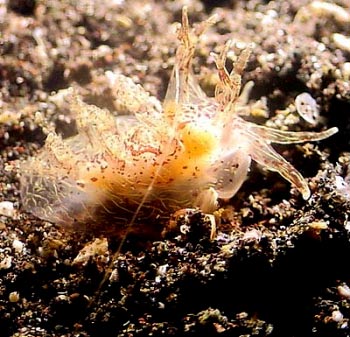
Pseudobornella orientalis
Baba, 1932
Order: NUDIBRANCHIA
Suborder: DENDRONOTINA
Family: Bornellidae
DISTRIBUTION
Known from Japan, and reported on the Forum from the Philippines
PHOTO
Ose Beach, Suruga Bay, Izu Peninsula, Japan. 5 April 2002, length approx 25mm. Photo: Pamun
See separate page for Anatomical Information
Described from 2 preserved specimens, 7mm long, little published information is available, except for the original anatomical description, and a recent photo in Okutani (2000: Marine Mollusks in Japan, p 798). The most distinctive external feature is the development on the rhinophoral sheath of a long slender tentacle, which can extend to at least twice the length of the body. The translucent whitish body has scattered brown spots and some yellow diagonal streaks. Baba reported that it was found feeding on the hydroid Tubularia mesembryanthemum attached to Zostera.
Reference:
• Baba, K. (1932) Pseudobornella orientalis, nov. gen. et sp. from Japan. Annotationes Zoologicae Japonenses, 13: 369-376.
Rudman, W.B., 2002 (April 8) Pseudobornella orientalis Baba, 1932. [In] Sea Slug Forum. Australian Museum, Sydney. Available from http://www.seaslugforum.net/find/pseuorie
Related messages
New observations on Pseudobornella orientalis
June 19, 2006
From: Song Xikun

Dear Bill,
After checking the original paper of Baba (1932) concerning Pseudobornella orientalis and all images in this forum that have been identified as P. orientalis, I think we might have been made some mistakes. In other words, some images might be not P. orientalis, at least different from the original animals discribed by Baba.
So, first of all, let us recall the descriptions of Baba:
(1) Habitat: According to Mr. Komori, Baba's specimens were found feeding on Tubularia mesembryanthemum Allman attached to Zostera at highwater mark in the front of the Misaki Marine Biological Station in May, 1931.
(2) According to a brief note by Mr. Komori, Baba's specimens bear numerous small irregular chocolate-coloured mottlings on the whole dorsal surface of the body. Small yellow lines are also visible on the back.The preserved specimen retains the chocolate-coloured mottlings on the translucent yellow ground of the body above.
Based on field surveys upon nudibranchs on Tubularia mesembryanthemum conducted during 2004-2006, I always found P. orientalis during December to the next May. When T. mesembryanthemum disappeared, the nudibranch disappeared, too. So P. orientalis shows high feeding specialization upon Tubularia mesembryanthemum. A possible reason for this association is that larvae of P. orientalis metamorphose only in the presence of its adult prey, Tubularia mesembryanthemum. If there are enough prey, the predator will survive. So when we collect P. orientalis, there must be T. mesembryanthemum nearby. For that reason I think the nudibranch I collected is the same as Baba's.
I have attached two images of a preserved specimen collected in the colony of Tubularia mesembryanthemum. I think this is what Baba would have seen in 1932. Notice the chocolate-coloured mottlings and long slender tentacles.
The images of Nishina Masayoshi are the common mode of P. orientalis, while those of Haruo Kinoshita and Tomohiko Kurihara seem to be different.
The last story is that all their images are found in sand, not the Tubularia colony. Maybe there are Tubularia nearby. Since my nudibranchs are all collected in fishnig nets, I have no chance to collect them in sand. Up until now, Pseudobornella contains only one species, but it is possible there might be other species in this genus.
Locality: Daisong Bay, 1-2 m, China, Taiwan Strait, 16 June 2006. Length: 12 mm. Photographer: Song.
Song Xikun
xksong@xmu.edu.cn
Song, X.K., 2006 (Jun 19) New observations on Pseudobornella orientalis. [Message in] Sea Slug Forum. Australian Museum, Sydney. Available from http://www.seaslugforum.net/find/16895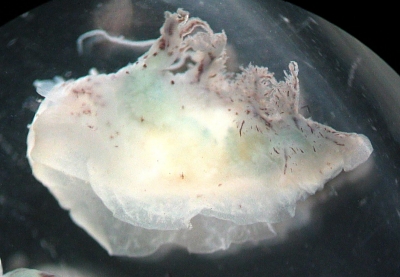
Dear Song,
Thanks for the confirmation that it feeds on Tubularia. However your comment that "A possible reason for this association is that larvae of P. orientalis metamorphose only in the presence of its adult prey, Tubularia" This is a bit like asking what came first - the chicken or the egg? Pseudobornella has evolved a close association with Tubularia, on which it feeds, and part of that association may be to trigger metamorphosis and settlement in veliger larvae. You can't say it feeds on Tubularia because that is what the larvae settle on - the reason the veliger settle on Tubularia is because the species has evolved a feeding association woth that hydroid.
I am not sure I see the differences you suspect in the different photos. To me the colour differences seem part of a normal range, but I am handicapped by never seeing this species alive. I look forward to further observations.
Best wishes,
Bill Rudman
Re: Is this Pseudobornella orientalis?
October 24, 2005
From: Song XiKun
Dear Bill,
Concerning your comments to my mesage #14556: I am sure that it's the eggs of this kind of nudi.
Before we took those photos, we observed it's laying eggs. We have observed two long threads on the rhinophore just similar to the finding of Nishina Masayoshi in April 16, 2002.
We have studied the morphology of its radula by SEM and it looks the same as Baba's illustrations.
Thank you!
XiKun Song
Xiamen University, China, PRC
xksong@yanan.xmu.edu.cn
Song, X.K., 2005 (Oct 24) Re: Is this Pseudobornella orientalis?. [Message in] Sea Slug Forum. Australian Museum, Sydney. Available from http://www.seaslugforum.net/find/15082Thanks Song,
Bill Rudman
Is this Pseudobornella orientalis?
October 20, 2005
From: XiKun Song
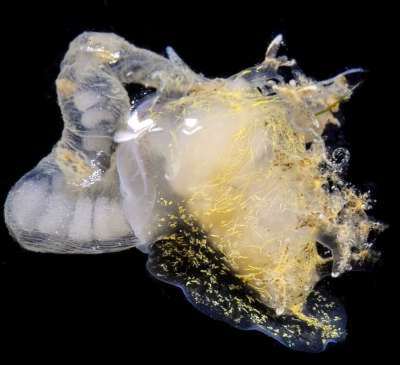
Dear, Bill
I am a postgraduate student at Xiamen University. Two undergraduates and I are taking a great interest in the taxonomy, morphology, distribution and larval metamorphosis of nudis. We choose Sakuraeolis enosimensis as our research model as it has a relatively broad distribution in China [messages #14610; #13615 ]
Locality: Xiamen, China. South China Sea. Depth: 1 m - 3 m. Length: All about 1 cm. 15 April 2005. Intertidal, fouling colonies. Photographer: Qin Ji
While doing this work we found a batch of nudis in marine fouling colonies, including what we think is an adult Pseudobornella orientalis. At last, I am wondering whether this is a new records for mainland China?
Thank you!
XiKun Song
xksong@yanan.xmu.edu.cn


Dear Song,
It is a bit hard to see the actual shape of the body, but I can see a long coiled papillae branching off the rhinophore sheath, which is rather characteristic of the species. In the lower right close up we can see eggs aranged in a spiral inside an egg case. Is this any thing to do with Pseudobornella, or is just something the animal was crawling on?
Best wishes,
Bill Rudman
Re: Pseudobornella orientalis from Philippines
March 25, 2004
From: Tomohiko Kurihara
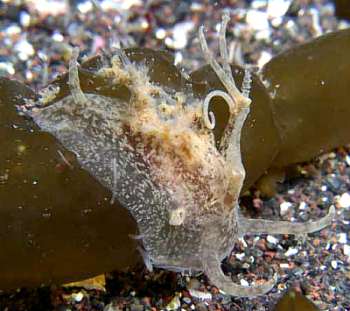
Dear Bill.
I found this animal which was very like the photograph of Shinji Kitagawa message #12463.
Here is a photo of an animal I don't think is Pseudobornella orientalis, although I saw typical Pseudobornella orientalis at the same place.
Although Pseudobornella orientalis has branched dorsal papillae like shown of the Anatomical Information Page, this animal has only one a pair of these branched papillae and a single long unbranched papillae on the tail.
What do you think?
Date: 13 March 2004 at night diving
Location: Osezaki, Suruga bay, Izu Peninsula, Japan
Depth: 14m
Length: about 25mm
Temp: 15 degrees C
Tomohiko Kurihara
tomo-coo@ny.tokai.or.jp
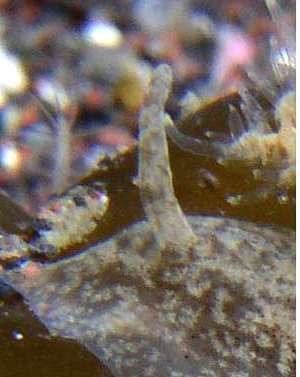
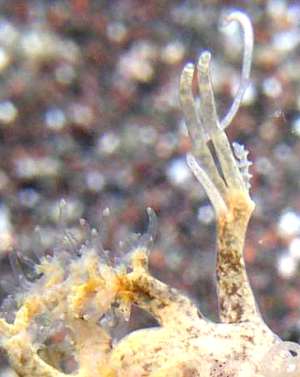
Dear Tomohiko,
I think this is a damaged individual. The unbranched papilla on the tail is almost certainly a branched one that had lost its branches. You can see some bumps on it which may be the 'stumps' of the lost branches. Even though your animal is damaged, your close-up photos of the rhinophore stalks and the gill-like branches on the mantle cerata are a valuable addition to out knowledge of this strange animal.
best wishes
Bill Rudman
Pseudobornella orientalis from Philippines
March 19, 2004
From: Shinji Kitagawa
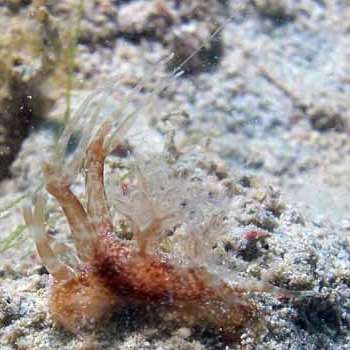
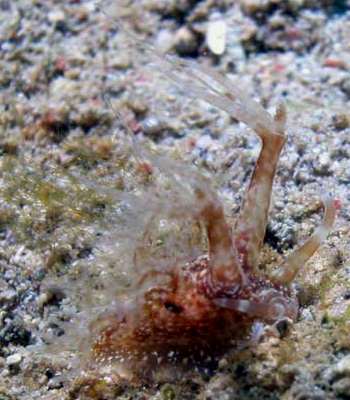
Dear Dr.Rudman
I took pictures of this nudibranch that I can not identify in Puerto Galera, Philippines. Could you identify this please?
28th January, 2004. 11:30AM
Location: Puerto Galera, Philippines
Depth: 10m
Length: 20-30mm
Water Temp.: 24C
Regards,
Shinji Kitagawa
mail@kitachan.net
Kitagawa, S., 2004 (Mar 19) Pseudobornella orientalis from Philippines. [Message in] Sea Slug Forum. Australian Museum, Sydney. Available from http://www.seaslugforum.net/find/12463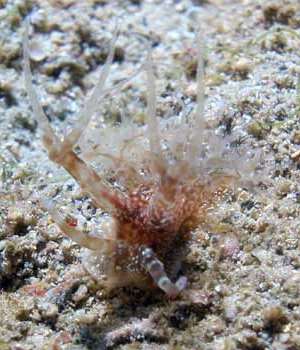
Dear Shinji,
It is difficult to be sure of the shape of the 'cerata' or 'papillae' on the back, as they are so transparent but I am pretty sure this is Pseudobornella orientalis. If, so it is a very interesting find as that species is only known from a few sightings in Japan. This is the first record of it outside Japan. Best wishes
Bill Rudman
Pseudobornella orientalis from the Japan Sea
July 15, 2002
From: Shigeru Hayashi
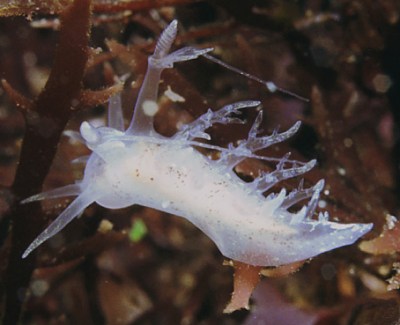
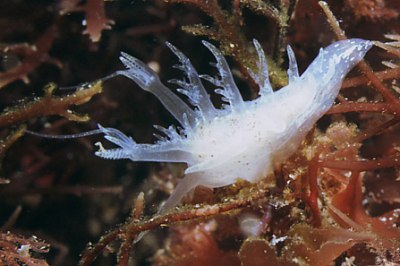
Dear Bill,
Here is a record of the uncommon Pseudobornella orientalis in the Japan Sea. The body color of this specimen was semi transparent. The Japanese name is based on the shape of the rhinophoral sheath and its long slender tentacle with trailing thread (Itohiki-umiushi).
Collection data: 2 March 2002, Uozu Toyama Bay, 20mm long alive, Water temperature 11.4deg C. Photo: H. Hagiwara - courtesy of the Takaoka Biological Club, Japan.
Best wishes.
Shigeru Hayashi
jr9dsx@tko.fitweb.or.jp
Hayashi, S., 2002 (Jul 15) Pseudobornella orientalis from the Japan Sea. [Message in] Sea Slug Forum. Australian Museum, Sydney. Available from http://www.seaslugforum.net/find/7453Thanks Shigeru,
Considering how uncommon animal this animal apparently is, we are indeed fortunate to have such a lot of excellent photos of it on the Forum. I am fascinating by the long slender trailing 'streamers' that you mention. From your photos they obviously drift in the current, much like a flag in the wind. It would be interesting to know if they have a function.
Best wishes,
Bill Rudman
Pseudobornella orientalis from Izu Penisula, Japan.
May 14, 2002
From: Haruo Kinoshita

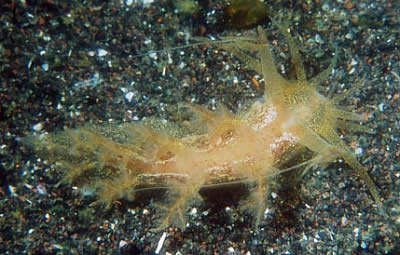
Dear Bill,
The attached pictures were taken by Miss Hisako Yamada. She took these pictures on sand bottom but actually found the slug on a rocky surface maongst a hydroid colony that was not Tubularia. There were also some other individuals on the same rock.
Date: 25-Apr-2001
Location: Ose-zaki, the west of Izu Peninsula, Japan
Depth: 30m
Length: 23mm
Watertemperature : 14c
Photo: Hisako Yamada
Thank you,
Haruo Kinoshita
kinoh@vesta.ocn.ne.jp
Kinoshita, H., 2002 (May 14) Pseudobornella orientalis from Izu Penisula, Japan.. [Message in] Sea Slug Forum. Australian Museum, Sydney. Available from http://www.seaslugforum.net/find/6851Dear Haruo,
Please thank Miss Hisako Yamada for these wonderful photos. In these photos the long filaments on the rhinophores look more like flags or the streamers female gymnasts wave around rather than sensory papillae. If they have a function, it is not very clear to me what it is.
best wishes,
Bill Rudman
Information on Pseudobornella orientalis
May 14, 2002
From: Nishina Masayoshi
Dear Bill,
I've the opportunity to discuss with Pamun, Yamada, Kinoshita, Kurihara, etc... their observations on Pseudobornella orientalis.
P.orientalis is often found on sandy bottoms in Spring. It is not a rare species in this period at Osezaki beach, Izu. Most times they were found on sands. It is easier to find it at night time than during the day so ir may be a nocturnal animal.
The average length of an adult is between 20mm to 30mm. When P. orientalis is fully grown, their mantle becomes like a film like an octopus has. P. orientalis can use it for floating. Kurihara has a good photo. It shows the film-like mantle. P. orientalis seems to live on or in the sand, and it may swim or float underwater occasionally with the film-like mantle. Some animals dislikes the light of a
flashlight and bury in the sand but some of them don't seem to notice.
P. orientalis is rarely found on the hydroid Tubularia mesembryanthemum but it does not seem to eat it. From Kurihara's observation, the thread on the rhinophores retracts and shrinks when something (like a floating minute animal) touches it but then it immediately extends out as it was.
Best Regards,
Nishina Masayoshi
nishina@wips.co.jp
Masayoshi, N., 2002 (May 14) Information on Pseudobornella orientalis. [Message in] Sea Slug Forum. Australian Museum, Sydney. Available from http://www.seaslugforum.net/find/6861Thanks Nishina,
It is indeed a fascinating animal. As I said to Tomohiko Kurihara I am pretty sure the film-like flaps, which as you say do remind us of an octopus, are the edge of the foot rather than the mantle. In these animals the 'edge' of the mantle is represented by the row of 'cerata/gills'.
Best wishes,
Bill Rudman
Pseudobornella orientalis from Japan
May 1, 2002
From: Tomohiko Kurihara
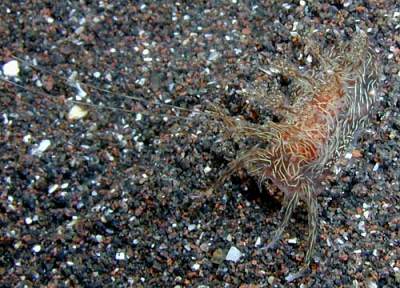
Dear Bill.
Here are photos of Pseudobornella orientalis Baba, 1932 I found at Osezaki, Izu Peninsula, Japan. It was crawling on a sandy bottom. It had a strange tentacle on each rhinophore which can stretch out and pull in when I touched it.
Another time I saw it floating in the sea. Also I think, it used the mantle-margin for floating. Mantle-margin was very wide open while floating. When it wanted to land on the bottom it closed the mantle-margin and changed shape to kind of U-shape. After it was able to land on the bottom.
The 'swimming photos' were taken at Osezaki, Suruga Bay, Izu Peninsula, Japan. Length: about 30mm. 10 April 2002
Best Regards,
Tomohiko Kurihara
http://www.ne.jp/asahi/kappa-kuri/miyamoto/OSEHOO/
miyamoto@info.email.ne.jp
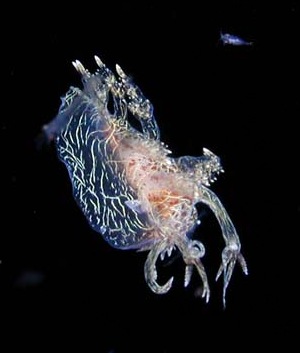
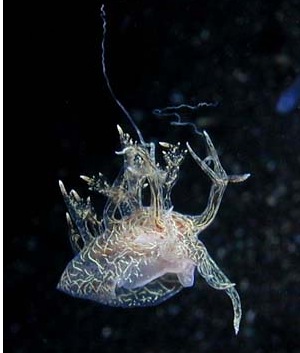
Dear Tomohiko,
Thanks for these interesting photos and observations. With your message and Nishina's we have learnt more about this species in a few weeks than we have in the last 60 years since it was first described. It certainly has similarities to the other opisthobranchs that live in sandy habitats. It would be wonderful to find out how it uses the long retractile tentacle on its rhinophores. Perhaps it searches out for its hydroid food. I suspect the wide flaps which you describe developing when it is swimming/floating are in fact the edge of the foot rather than the mantle for these animals don't really have a mantle edge. Again, other sand-dwelling species have very a very large foot and some of them, such as Euselenops and Kalinga ornata use the extended edges of the foot to swim/float.
Best wishes,
Bill Rudman
Pseudobornella orientalis
April 16, 2002
From: Nishina Masayoshi

Dear Bill,
Here is a photo of Pseudobornella orientalis Baba, 1932 photographed by Pamun who is an owner of a diving operation named MIRISSA at Osezaki Beach, Suruga bay, Izu Peninsula. She often gives me information on sea slugs which lives in Osezaki.
I have never seen this animal but it has a very unique feature, which I hope you can see in the photo - the long thread on the rhinophore. There is able to stretch to about two times the body length. Pamun says that this animal lives in the sand in the daytime and when night comes, it creeps
out on the sand.
DATE:5 April 2002
LOCATION:Ose beach, Suruga bay, Izu Peninsula, Japan
LENGTH: about 25mm
PHOTO BY: Pamun
http://ww4.et.tiki.ne.jp/~pamun/
Best Regards,
Nishina Masayoshi
nishina@wips.co.jp
Masayoshi, N., 2002 (Apr 16) Pseudobornella orientalis. [Message in] Sea Slug Forum. Australian Museum, Sydney. Available from http://www.seaslugforum.net/find/6712Dear Nishina,
Thanks for this very interesting photo. It is the first time I have seen a photo of the whole animal. As far as I know it is the first information since it was described by Baba in 1932. I have copied some of Baba's drawings on a separate page.
It is exciting to hear that this is another sand-dwelling nudibranch. Perhaps the long extensile 'tentacle' is associated with its burrowing habit. It would be great to confirm that it feeds on the hydroid Tubularia as reported to Baba by his collector.
Best wishes,
Bill Rudman
